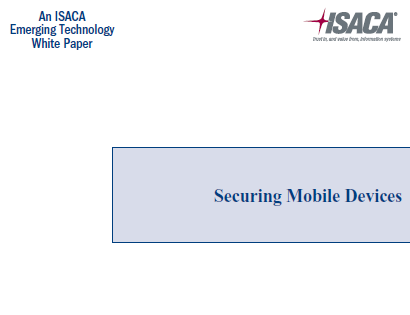In the complimentary new white paper titled "Securing Mobile Devices," ISACA, a leading global association for enterprise governance of information technology (IT), noted that the use of wireless networks, typically less secure than wired networks, leaves information at greater risk for interception. From smartphones to USB sticks, many devices also store data that are unencrypted, which can result in sensitive information being compromised through interception and device theft or loss. Mobile devices can also be the targets of malware attacks as employees carry them beyond the protection of their company's network.
The white paper notes that a lack of enterprise control of physical devices, along with the growing practice of employees using personal devices for business, has increased mobile device risk levels.
According to the Ponemon Institute's Global 2009 Annual Study on Cost of a Data Breach, 32 percent of all data breach cases in the study involved lost or stolen laptop computers or other mobile data-bearing devices. While the average organizational cost of a data breach was US $3.4 million, all countries in the study reported noticeably higher data breach costs associated with mobile incidents.
"Ironically, many of the risks associated with mobile devices exist because of their biggest benefit: portability," said ISACA white paper project development team member Mark Lobel, CISA, CISM, CISSP, and principal, PricewaterhouseCoopers. "To help their company meet its goals of protecting intellectual property and sustaining competitive advantage, information security managers need to create an easily understood and executable policy that protects against risks related to leaking confidential data and malware."
A governance framework such as COBIT or Risk IT will help businesses ensure that process and policy changes are implemented and understood, and that appropriate levels of security are applied to prevent data loss. ISACA advocates that the following issues be considered when designing a mobile device strategy:
• Define allowable device types (enterprise-issued only vs. personal devices).
• Define the nature of services accessible through the devices.
• Identify the way employees use the devices, taking into account the organization's corporate culture, as well as human factors. (For example, one in 10 Americans who use a mobile work device plan to use it for holiday shopping.*)
• Integrate all enterprise-issued devices into an asset management program.
• Describe the type of authentication and encryption that must be present on devices.
• Clarify how data should be securely stored and transmitted.
"Mobile technology can offer enterprises several highly valued benefits, from increased productivity to better customer service, but it is important to recognize that these benefits can be realized only if the enterprise manages the technology effectively-for both value and risk," said Adam Meyers, a member of ISACA's white paper project development team and senior principal at SRA International.


















